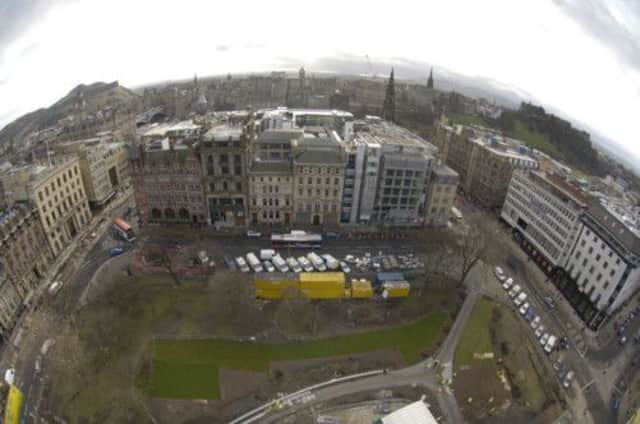Malcolm Fraser: Backbone can keep Provident standing


There’s a wonderful thread on the Hibernian Supporters’ website titled “1960s architecture in Edinburgh… is good for the city”, where a group of Hibees debate the merits of the best of Edinburgh’s modern buildings, offering sophisticated praise for buildings they agree to be “masterpieces”.
They’re clear that some development from that time was poor but eloquent about the best, giving the lie to the patronising view that “ordinary people don’t appreciate modern architecture”. This opinion, formed on behalf of us all, gives the Establishment an additional stick with which to attack our built environment. The standard arguments for demolishing masterpieces from the past are that “it would cost thousands to repair the roof” (so we spend millions demolishing and building anew) and that “it’s no longer fit-for-purpose” (see my daughters’ Boroughmuir School where, instead of adapting its sturdy 100-year fabric for the next 100 years the Council are building a new one, outside the catchment area, that will be “fit” for a fraction of the time). For a modern masterpiece we add the dreaded “modern buildings are not proper heritage, and ordinary people don’t like them”.
Advertisement
Hide AdAdvertisement
Hide AdThe 1960s was a wee golden age for Edinburgh architecture. The best of its buildings include the Commonwealth Pool, Mortonhall Crematorium, the original Pollock Halls and Basil Spence’s Canongate tenements – all exhibiting the openness, structural innovation and play with light that characterised the humane architecture of the time. But the favourite of many of the Hibee sophisticates and possibly the most celebrated – it sits above them all at No 8 in the Prospect List of the 100 Best Modern Buildings in the whole of Scotland – is the Scottish Provident Institution on St Andrew Square.
It’s a beautiful building; it’s open, light-filled floors clearly of its time. But it also sits beautifully in its New Town context and the Georgians would surely have admired its calm rationality, clear entry and generosity in inviting in light. It’s a Georgian house, brought forward in time and scaled-up to match the Victorian palazzos that surrounded it.
It is listed by Historic Scotland as a building of national importance, its heritage validated by academic evaluation from august bodies such as the Architectural Heritage Society of Scotland and the Scottish Civic Trust. It’s in good condition, provides open, flexible space, and sits in a vibrant part of town.
And that town – our Edinburgh – relies heavily on such heritage for its wealth and happiness. Our built heritage and its magnificent integration into our extraordinary geology is the USP that sits behind all our other claims to vibrancy, giving us the ability to attract and retain business and tourism as well as host the world’s greatest arts festival. Our heritage is our wealth, but it also, under some dumb economic models, stands in the way of our “economic development”; and so this fine building is up before the planning committee tomorrow, with a recommendation for demolition.
How has this happened? First, in what the Cockburn Association, in a formal complaint to the Ombudsman, describes as a deliberate deception by council officers, in pretending that this is not a formal “demolition” in order to avoid the proper tests that would then apply. The proposal is to take the whole building down… and then glue a few bits of the old frontage back on to a new building, to provide a façade that looks a bit like the old one. Aside from the fact that such scrapbook-façadism is universally derided, traducing our heritage for no benefit, the proposal clearly is “demolition”, as Historic Scotland – the Council’s principal advisors here – have clearly stated. The officers’ position, that a bit of gluing somehow avoids the use of the bad word, is untenable.
I hope that, as I write, there’s a wee panic going on in the council planning department. It’s unusual for institutions to admit they’ve erred, but I think they might save themselves from censure if they withdraw the report and go back and insist that the description and, therefore, the process, changes.
They do have my sympathy though, as all such institutions are under pressure to cave in to the daftest commercial demands of the “economic development” imperative.
For example on a lovely New Town building with a grand arcaded stone opening to a rear saloon, which was being redeveloped and rented-out to a restaurant. The agents controlling the deal wanted the arcade ripped out, as it made the building more flexible. I countered that the restaurant would like that arcade; but was told that we should take it out, then trick it back in plasterboard to suit. We stalled and ran out of time. But the disconnect between the funny money of the agent’s figures, and the real value in the arcade, was an eye-opener.
Advertisement
Hide AdAdvertisement
Hide AdIt’s a similar issue on St Andrew Square. The block is to be redeveloped and the agents want theoretical space throughout that has a greater height than our small listed section. But the final development will require staff rooms, meeting rooms, offices and suites and any good architect (can I volunteer?) would love the challenge.
The purpose of the listings process is to protect the heritage which is of such value the city. Put a different way you could say that it is there to stop developers doing the dumbest thing available to them. If they have to work a little harder, and be a little more imaginative, then that is what is necessary – and entirely justifiable – in a place like Edinburgh. I look forward to the council showing a bit of backbone.
• Malcolm Fraser is an Edinburgh architect and chairs the Scottish Government’s town centre review
SEE ALSO